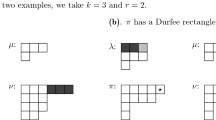Abstract
Motivated by a recent paper of Straub, we study the distribution of integer partitions according to the length of their largest hook, instead of the usual statistic, namely the size of the partitions. We refine Straub’s analogue of Euler’s Odd-Distinct partition theorem, derive a generalization in the spirit of Alder’s conjecture, as well as a curious analogue of the first Rogers–Ramanujan identity. Moreover, we obtain a partition theorem that is the counterpart of Euler’s pentagonal number theorem in this setting, and connect it with the Rogers–Fine identity. We conclude with some congruence properties.



Similar content being viewed by others
References
Alder, H.L.: Research problems. Bull. Am. Math. Soc. 62(4), 76 (1956)
Alfes, C., Jameson, M., Oliver, R.: Proof of the Alder-Andrews conjecture. Proc. Am. Math. Soc. 139(1), 63–78 (2011)
Andrews, G.E.: On a partition problem of HL Alder. Pac. J. Math. 36(2), 279–284 (1971)
Andrews, G.E.: Two theorems of Gauss and allied identities proved arithmetically. Pac. J. Math. 41(3), 563–578 (1972)
Andrews, G.E.: JJ Sylvester, Johns Hopkins and partitions. Century Math Am Part I I, 21–40 (1988)
Andrews, G.E.: The Theory of Partitions, vol. 2. Addison-Wesley Publishing Company, Boston (1976)
Andrews, G.E., Eriksson, K.: Integer Partitions. Cambridge University Press, Cambridge (2004)
Benjamin, A.T., Quinn, J.J.: Proofs that Really Count: The Art of Combinatorial Proof. MAA Service Center, Delhi (2009)
Berndt, B.C., Yee, A.J.: Combinatorial proofs of identities in Ramanujan’s lost notebook associated with the Rogers-Fine identity and false theta functions. Ann. Comb. 7(4), 409–423 (2003)
Corteel, S., Lovejoy, J.: Overpartitions. Trans. Am. Math. Soc. 4, 1623–1635 (2004)
Euler, L.: Introductio in Analysin Infinitorum, vol. 2. MM Bousquet, Hanson (1748)
Euler, L.: Observationes analyticae variae de combinationibus. Commentarii academiae scientiarum Petropolitanae 13(1751): 64-93. Reprinted in OO, I, 2: 163–193
Fine, N.J.: Basic Hypergeometric Series and Applications. American Mathematical Society, Providence (1988)
Franklin, F.: Sur le développement du produit infini \((1-x)(1-x^2)(1-x^3)(1-x^4)..\). Comptes Rendus 82, 448–450 (1881)
Keith, W.J., Nath, R.: Partitions with prescribed hooksets. J. Comb. Number Theory 3(1), 39–50 (2011)
Munarini, E., Salvi, N.Z.: Structural and enumerative properties of the Fibonacci cubes. Discret. Math. 255, 317–324 (2002)
Ramanujan, S.: The Lost Notebook and Other Unpublished Papers. Narosa, New Delhi (1988)
Straub, A.: Core partitions into distinct parts and an analog of Euler’s theorem. Eur. J. Comb. 57, 40–49 (2016)
Subbarao, M.V.: Combinatorial proofs of some identities. In: Proceedings of the Washington State University Conference on Number Theory, pp. 80–91 (1971)
Yee, A.J.: Partitions with difference conditions and Alder’s conjecture. Proc. Natl. Acad. Sci. USA 101(47), 16417–16418 (2004)
Author information
Authors and Affiliations
Corresponding author
Additional information
Both authors were supported by the Fundamental Research Funds for the Central Universities (No. CQDXWL-2014-Z004) and the National Science Foundation of China (No. 11501061).
Rights and permissions
About this article
Cite this article
Fu, S., Tang, D. Partitions with fixed largest hook length. Ramanujan J 45, 375–390 (2018). https://doi.org/10.1007/s11139-016-9868-z
Received:
Accepted:
Published:
Issue Date:
DOI: https://doi.org/10.1007/s11139-016-9868-z
Keywords
- Euler’s partition theorem
- Euler’s pentagonal number theorem
- Rogers–Ramanujan identity
- Rogers–Fine identity
- Fibonacci number




